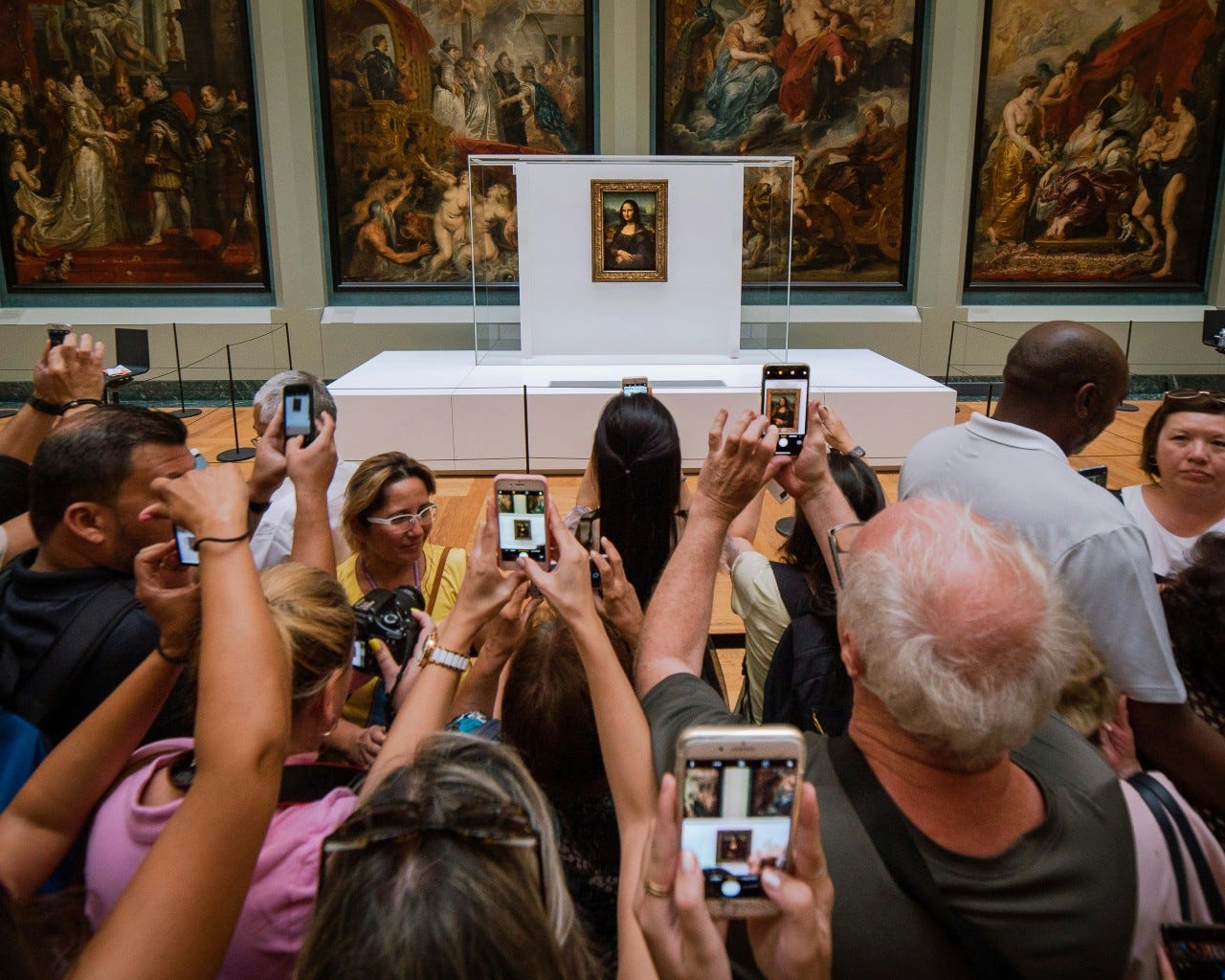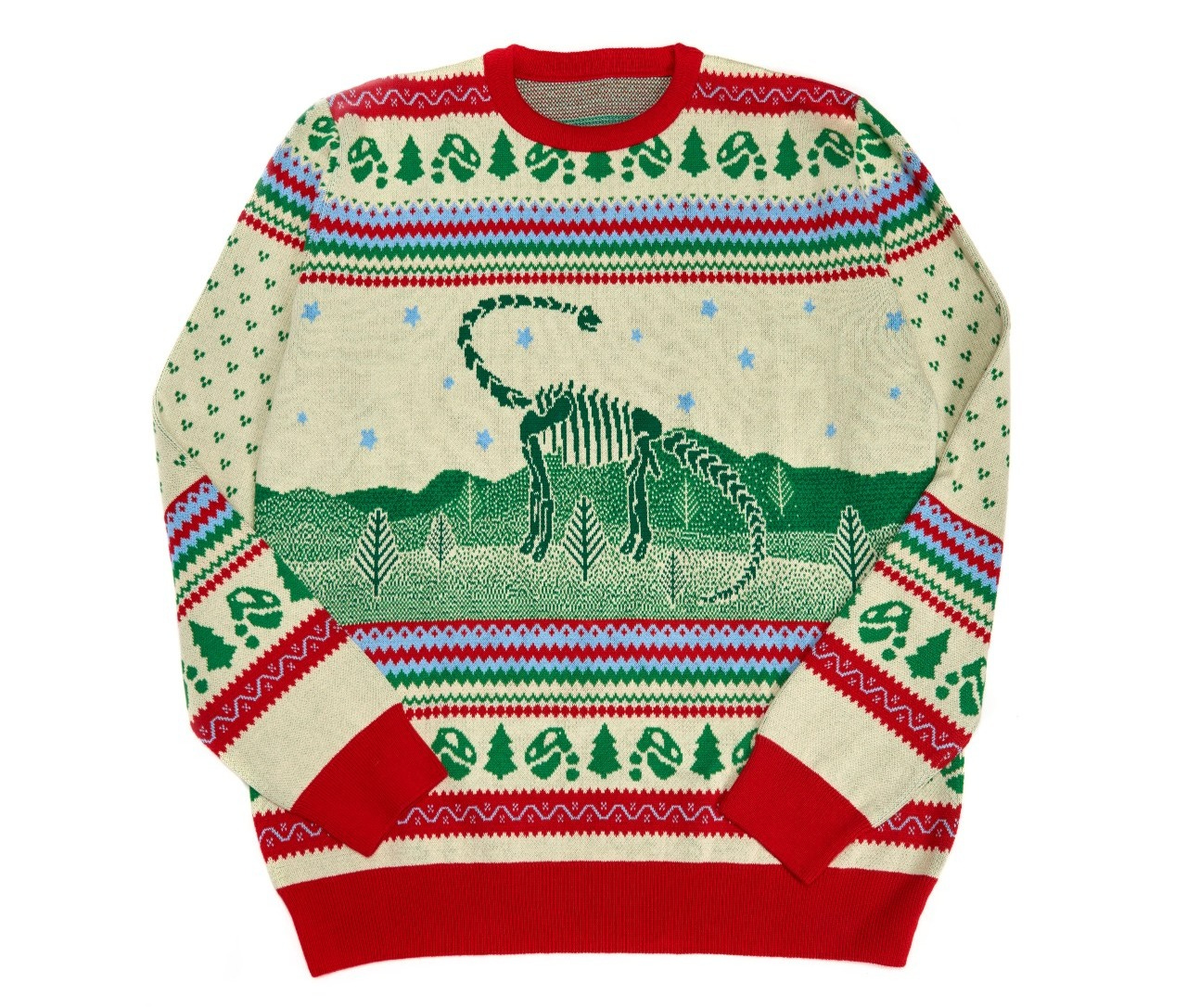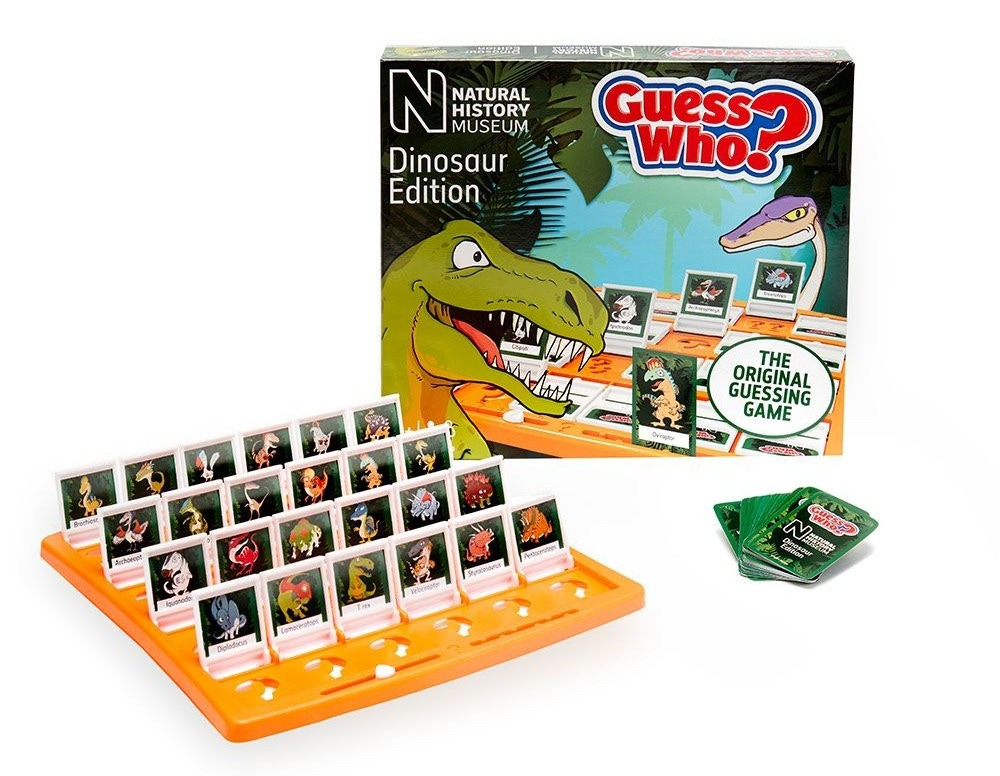Hello.
It’s Wednesday in December, so I bring you my usual features newsletter but with a festive twist!
It’s beginning to look at lot like Christmas if you hadn’t noticed. Although the Natural History Museum has been looking festive for a couple of weeks already as part of its annual Yuletide transformation of its much-loved T.rex, and its efforts to entice Christmas shoppers. Today’s Big Interview goes down the chimney with the museum’s Head of Retail to discuss what makes a museum shop pop at Christmas.
The Hot List today is the second year I’ve asked leading names from the museum world to recommend the books they most enjoyed over the past year. With Christmas just 21 days away — three weeks exactly! — I hope it gives you some inspiration for your gift buying. (Plus, purchasing these books through the links included below, you’ll be financially supporting this newsletter at no extra cost to you). And you’ll see that one book was particularly popular.
And in the 250 Take, revisit one of the most reacted-to guest columns I published this past year.
Let’s dive right in!
— maxwell
The Hot List
This week in a special edition of my Hot List, I ask five leading figures to recommend the book they most devoured in 2024.
*Purchasing through the below links helps fund this newsletter by earning me a valuable affiliate commission
🗣 Luke Syson, Director and Marlay Curator of the Fitzwilliam Museum
📖 The Garden Against Time: In Search of a Common Paradise by Olivia Laing
The American artist Glenn Ligon has arranged a truly magnificent display of our flower paintings at the Fitzwilliam, revealing them as beautiful but troubling too. Laing’s rambling rose of a book does the same for the gardens they grew in — a sweeping landscape of yearning and control, gender, politics and race. [Buy a copy]
🗣 Caroline Campbell, Director of the National Gallery of Ireland
📖 Architecture in Britain and Ireland, 1530-1830 by Steven Brindle
I want to recommend Steven Brindle’s major new history of architecture. I loved the sweep of the narrative, the inclusion of much that previous architectural histories have ignored, as well as the informed discussion of familiar buildings. It’s also beautifully produced and illustrated. Truly a lifetime achievement. [Buy a copy]
🗣 Jonathan Badyal, Deputy Chair of the Black Country Living Museum, and Director of Communications at Universal Music UK
📖 The Creative Act: A Way of Being by Rick Rubin
This is an easy one as it’s the book I have probably gifted more than any before! Rick Rubin is the co-founder of Def Jam Records, and this is an astonishingly searching book, but equally it is full of simple tips and tricks for finding your inner creativity. [Buy a copy]
🗣 Emma Harper, Curator at the Charles Dickens Museum
📖 Divine Might: Goddesses in Greek Myth by Natalie Haynes
Outside of my work I’m not a big non-fiction reader but Natalie Haynes makes reading anything a pleasure! Here she explores goddesses from a feminist perspective. Exploring how both the goddesses and myths have been portrayed over the centuries from the original sources to contemporary culture, Haynes uses her wit and passion to make us look afresh at these stories. [Buy a copy]
🗣 Dr Sam Lackey, Director of Liverpool Biennial
📖 The Garden Against Time: In Search of a Common Paradise by Olivia Laing
My most annotated and post-it-noted book (always a good sign) this year, was Olivia Laing’s beautiful book. As always, Laing’s writing does that deft dance between literature, art, politics, history and experience, drawing you down her garden path with a sense of much-needed possibility. [Buy a copy]
The Big Interview
The Natural History Museum in London is having a ROAResome Christmas.
For the fourth year in a row, they’ve transformed their much-loved animatronic T.rex into a festive spectacle. Not only is its pre-historic home in the popular Dinosaur Gallery now a snowy scene reminiscent of a Richard Curtis movie, the enormous predator is for the next few weeks sporting a newly commissioned Christmas jumper and Santa hat.

The makeover is part of the museum’s Christmas offering to pull in the punters — and to get the tills ringing. As with all museums and galleries, the most wonderful time of the year is big business.
And so the Natural History Museum isn’t just creating knitwear for the T.rex, it’s a created a bespoke range that’s available in human sizes too. There’s a wider gift selection as well, with even an edible version of the T.rex on sale (it’s an iced gingerbread biscuit by Biscuiteers and is delicious FYI).
So to get an insight on this really important part of museum activity, my interview today is with Claire Bevan, Head of Retail and Customer Contact at the Natural History Museum. She oversees the South Kensington museum’s festivities, as well as the retail offer all-year-round. Here we chat about the holiday season’s challenges an opportunities, the work that goes into planning for the festive rush, and the gifts that are flying off the shelves this at the NHM this Christmas.
Hi Claire. So firstly, how a big deal is Christmas for the Natural History Museum?
Christmas is an exciting time for the Museum every year, and something our visitors enjoy.
At South Kensington we have several events like Storytelling with Father Christmas, Christmas at the Museum late-night event and our ever-popular New Year’s Eve party.
We expect to see around 900,000 visitors to South Kensington alone in November and December. It’s a very important time for the retail team, both onsite and our online shop will have its biggest months.
You've just launched your T.rex Xmas jumper project — how long was that in the planning?
Planning for the T. rex starts about a year ahead and is led by the retail team (and seems to get earlier every year!).
Each year has a key theme, and 2024 celebrated our newest resident Fern the Diplodocus, which made its home in our newly transformed gardens this summer. The jumper features Fern, and the campaign creative shows Fern and its dinosaur friends having their first Christmas party in the Museum. Our decorations also follow the theme with tyrannosaurs in jumpers and party themed dinosaurs.
Our main aims for this annual project is to create a fun experience for our visitors, sell associated products and promote the Museum over the Christmas period. The press team are a key part of the success, leading on external comms, proposing initiatives and hooks to improve engagement, and they lead events like early morning visits with media and content creators.
Do you see an uplift in visitors coming to see the T.rex?
Customers love it — and they actually start getting in touch from October asking when we will be launching the T. rex. This year we even had visitors from Germany planning their visit to see it!
Since the first launch in 2021, we’ve seen big year-on-year increases to the Dinosaur Gallery, with 126,000 visitors since the launch this year. That’s a 61% increase vs 2019. We also look at the press reach of the campaign, with an estimated 330M impressions this year so far.
What's flying off the shelves so far this Christmas at NHM?
As usual the organic cotton Christmas jumper is our biggest seller, followed by our exclusive decorations and children’s games like NHM Dinosaur Guess Who. Our Wildlife Photographer of the Year ranges also launch in October and our bespoke prints featuring the winning photographs are some of our bestsellers there.
What's the biggest challenge for you and the team over Christmas?
Predicting demand is probably the biggest challenge for us.
With most of the products we buy in specifically for Christmas — like the jumper and decorations — we don’t have an opportunity to reorder due to the finite gift-buying period. So it’s important we can satisfy demand whilst not leaving us with lots of excess stock after the big day.
It’s also a busy time for the team, with onsite and online launches, the shop floor and wider museum getting busier, and we also start the planning for the next year at the same time. So it’s important we all remember to look after our energy levels up to the Christmas break.
Tell us about how you create product range?
Creating product ranges is one of the most exciting parts of what we do.
We start with the audience and any key themes. If the product range is for an exhibition or seasonal event, there will be clear direction and a set of assets we can use, for example the winning photographs from Wildlife Photographer of the Year. We will predict demand based on expected visitor numbers, this establishes our budget, and we set a margin expectation.
To decide on what sits in the range we will look at our previous bestselling products for the type of exhibition, and work with our established supplier base to create most of the range.
Where we identify gaps in product or price points — or if want to try something new, like this year introducing sunglasses made from recycled ocean plastic from Waterhaul — we will bring on new suppliers. Sustainable materials and responsible manufacturing practices are essential in our choice of products and suppliers.
What do you think makes a good museum shop?
A good museum shop is one that reflects the experience of visitors, and which makes them feel seen as a customer. The products should feel carefully chosen, and offer something different to the high street, and the environment should be welcoming and inclusive. You should also feel that it lives up to the values of the organisation you’ve spent your time coming to visit.
The Natural History Museum has a mission to create advocates for the planet. Those are individuals who feel sufficiently informed, confident and motivated to make wise decisions, to get involved, and to use their influence and actions to make a positive difference to the global future. We try to reflect that with sustainable choices in our product development.
For instance, for our Christmas range we worked with sustainable clothing enterprise NotJust Clothing on a knitwear collection made from organic cotton, plus we have no glitter in our decorations which are made from natural materials.
What’s the main metric or KPI — key performance indicator — you pay attention to?
The main KPIs we look at are average transaction value (ATV), conversion and margin.
Conversion — the percentage of visitors to our museum who make a purchase — is particularly important because it is a great barometer for how the business is achieving across several points. Are we delivering a desirable product range, successfully targeting our audience and are selling in an engaging environment that isn’t presenting significant barriers to purchase (for example price, or simply a long queue)? We then have several data touch-points that help us further interrogate our results, like our monthly visitor survey.
Finally, how will you be spending Christmas?
We close the Museum from 24 to 26 December so it’s a great time for the whole team to have a break.
I will be spending Christmas with my family. While I love living in London, I really look forward to spending some time in the countryside walking the family dogs and eating lots of delicious food. Here’s hoping for some picture-perfect snow for Christmas Day!
The Natural History Museum’s 2024 Christmas jumper — modelled by the Museum’s famous animatronic Tyrannosaurus Rex — is available in store and online now. See the festive T.rex until early January 2025.
The 250 Take
As we near the end 2024, the year’s penultimate opinion column from a guest writer reposts one of the most reacted-to 250 Takes of the past year.
So here again is journalist Lucy Thackray with her take — in 250 words — on why camera phones have ruined the gallery-going experience.
💬 Museums: it’s time to ban phones
“On a recent New York trip, I slipped out of central Manhattan into MoMA, in search of some peace and connection with the art. Instead of cultural heaven, I found myself in social media hell ‒ ducking and diving to avoid visitors zooming in, filming video or taking selfies with the works. It now seems most of us are experiencing MoMA through a six-inch screen. It felt dystopian: was no one here to simply look and feel, without a proof-of-attendance photo?

I’d forked out $30 for entry, but the visit quickly felt cheapened. In one interactive installation, retro phones can be picked up to hear poetry recited. But hardly anyone was participating ‒ they were too busy snapping the view from the sidelines. Firstly, I’m baffled by the impulse to capture your individual view of a painting ‒ hardly original content when the same angle is found in seconds on Google images. Secondly, isn't our collective phone obsession putting a barrier between us and the transformative nature of art? My instinct is that it needs to be taken out of our hands: literally and metaphorically.
Perhaps museums could offer discounts to those who conceal devices in a sealed bag, as they do at Secret Cinema, or leave them in lockers. After all, people expect to switch off for other mediums, such as theatre. Another move might be banning photography, but providing official, social-ready pictures to visitors after a visit, with encouragement to share. Museums: the ball is in your court.”
— Lucy Thackray has written for The Sunday Times, The Independent, and many others. She’s been a full-time travel editor and writer for 15 years.
Enjoyed this newsletter? It took many hours to put together. Donate now to support me as I continue to bring you insights from the world of museums, galleries, art and heritage.







I totally disagree with Paolo. Phones are universal not “commoners’ stuff”. It is not a sacred experience that I am after, I simply want to be able to look at the paintings in the exhibition . Those that take photos need to be quite close to the painting without anyone in front of them, they then take up the space of three people by holding the phone up to their eye. In the once in a lifetime exhibition at present in The National Gallery it is very busy which is to be expected so it is especially galling. It is time the museums had the courage to take action either by a complete ban or by giving special times of the day - early or late? - when cameras would be allowed in.
I always am grateful to the private collectors who give up their paintings for an exhibition and I have noticed on a previous occasion that sometimes photography is not permitted of certain paintings.
There's a reflection to be made about privilege in here...
The discussion about banning phones can quickly enter classism territory. Phones are perceived as "commoners' stuff" and their presence one that "cheapens" the museum experience. But most people who are in a museum at any given time - and especially those who visit massive attractions such as the MoMA - don't go to museums all the time. We can't ask visitors to come en masse so the museum raises money, and then ask them to come in as some sort of sacred experience where they should just be thankful that they're allowed in.
On a vaguely related note, will there be a book recommendations part 2 with Front of house staff? They usually have the most diverse and most interesting suggestions!